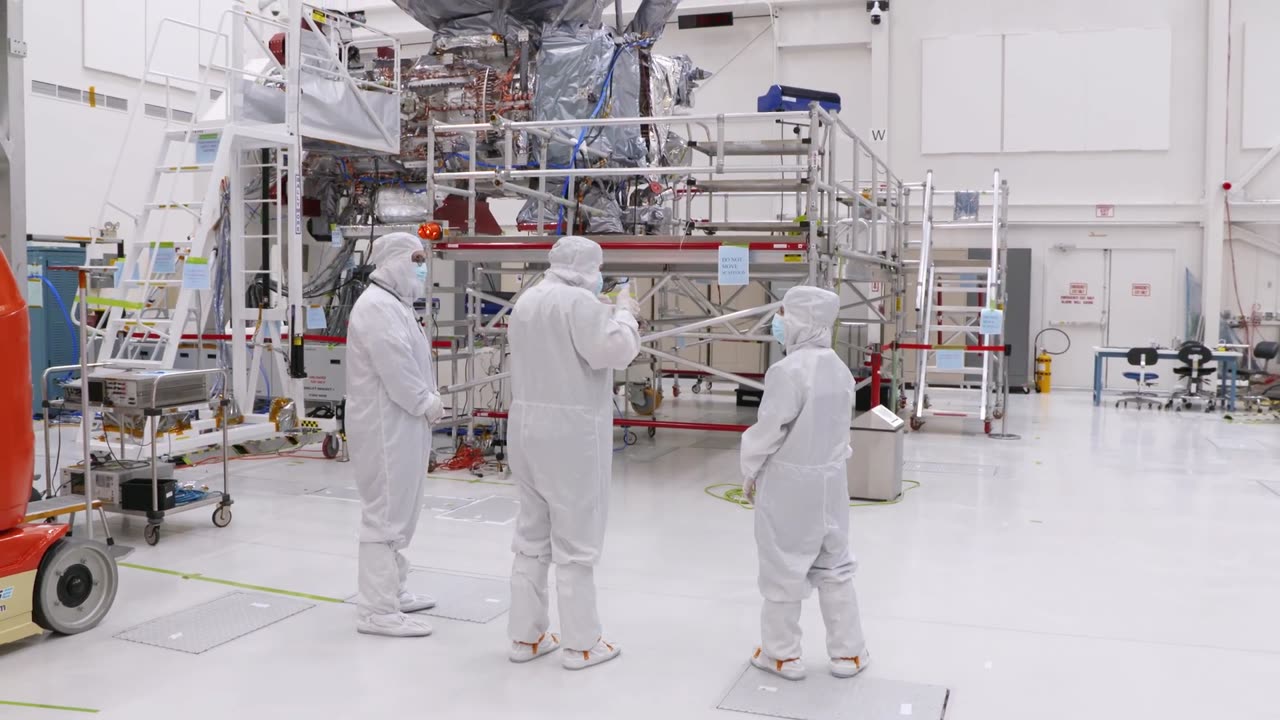Premium Only Content

Spacecraft Makers: Europa Clipper's Instrument Integration
#spacecraft #europaclippers #integration #spaceship #nasa #galaxies #spacerocket #rocket #aircraft #solarsystem #planets #wolfchamp
Spacecraft Makers: Europa Clipper's Instrument Integration
Hardware for NASA’s Europa Clipper spacecraft was developed at various institutions and facilities across the U.S. and Europe, including NASA's Jet Propulsion Laboratory. That work included the science instruments and other spacecraft components, such as the propulsion module, radio frequency module, solar arrays, electronics vault, and more.
During the assembly, test, and launch operations phase of the mission, engineers put together the spacecraft, test its various components, and prepare it for its launch and journey to Jupiter’s ice-encrusted moon Europa.
In this episode of the Spacecraft Makers video series, spacecraft assembly, test, and launch operations mechanical engineer Steve Barajas and science systems engineer Jenny Kampmeier provide a behind-the-scenes look at the nearly completed spacecraft in the High Bay 1 clean room at JPL.
The propulsion module for the spacecraft was built by the Johns Hopkins Applied Physics Laboratory (APL) in Laurel, Maryland, with help from NASA’s Goddard Space Flight Center in Greenbelt, Maryland, and JPL.
The science instruments were developed by APL, the School of Earth and Space Exploration at Arizona State University, Southwest Research Institute in San Antonio, JPL, UCLA, University of Michigan, University of Texas at Austin, and the Laboratory for Atmospheric and Space Physics at the University of Colorado Boulder.
Spacecraft Makers is a video series that takes audiences behind the scenes to learn more about how space missions, like Europa Clipper, come together. Europa Clipper will explore this icy moon of Jupiter to see if there are conditions suitable for life. The spacecraft needs to be hardy enough to survive a 1.6 billion-mile, six-year journey to Jupiter – and sophisticated enough to perform a detailed science investigation of Europa once it arrives at the Jupiter system in 2030.
Europa Clipper is expected to launch in October 2024 from Kennedy Space Center in Florida.
Spacecraft Makers: Europa Clipper's Instrument Integration
Hardware for NASA’s Europa Clipper spacecraft was developed at various institutions and facilities across the U.S. and Europe, including NASA's Jet Propulsion Laboratory. That work included the science instruments and other spacecraft components, such as the propulsion module, radio frequency module, solar arrays, electronics vault, and more.
During the assembly, test, and launch operations phase of the mission, engineers put together the spacecraft, test its various components, and prepare it for its launch and journey to Jupiter’s ice-encrusted moon Europa.
In this episode of the Spacecraft Makers video series, spacecraft assembly, test, and launch operations mechanical engineer Steve Barajas and science systems engineer Jenny Kampmeier provide a behind-the-scenes look at the nearly completed spacecraft in the High Bay 1 clean room at JPL.
The propulsion module for the spacecraft was built by the Johns Hopkins Applied Physics Laboratory (APL) in Laurel, Maryland, with help from NASA’s Goddard Space Flight Center in Greenbelt, Maryland, and JPL.
The science instruments were developed by APL, the School of Earth and Space Exploration at Arizona State University, Southwest Research Institute in San Antonio, JPL, UCLA, University of Michigan, University of Texas at Austin, and the Laboratory for Atmospheric and Space Physics at the University of Colorado Boulder.
Spacecraft Makers is a video series that takes audiences behind the scenes to learn more about how space missions, like Europa Clipper, come together. Europa Clipper will explore this icy moon of Jupiter to see if there are conditions suitable for life. The spacecraft needs to be hardy enough to survive a 1.6 billion-mile, six-year journey to Jupiter – and sophisticated enough to perform a detailed science investigation of Europa once it arrives at the Jupiter system in 2030.
Europa Clipper is expected to launch in October 2024 from Kennedy Space Center in Florida.
Spacecraft Makers: Europa Clipper's Instrument Integration
Hardware for NASA’s Europa Clipper spacecraft was developed at various institutions and facilities across the U.S. and Europe, including NASA's Jet Propulsion Laboratory. That work included the science instruments and other spacecraft components, such as the propulsion module, radio frequency module, solar arrays, electronics vault, and more.
During the assembly, test, and launch operations phase of the mission, engineers put together the spacecraft, test its various components, and prepare it for its launch and journey to Jupiter’s ice-encrusted moon Europa.
In this episode of the Spacecraft Makers video series, spacecraft assembly, test, and launch operations mechanical engineer Steve Barajas and science systems engineer Jenny Kampmeier provide a behind-the-scenes look at the nearly completed spacecraft in the High Bay 1 clean room at JPL.
The propulsion module for the spacecraft was built by the Johns Hopkins Applied Physics Laboratory (APL) in Laurel, Maryland, with help from NASA’s Goddard Space Flight Center in Greenbelt, Maryland, and JPL.
The science instruments were developed by APL, the School of Earth and Space Exploration at Arizona State University, Southwest Research Institute in San Antonio, JPL, UCLA, University of Michigan, University of Texas at Austin, and the Laboratory for Atmospheric and Space Physics at the University of Colorado Boulder.
Spacecraft Makers is a video series that takes audiences behind the scenes to learn more about how space missions, like Europa Clipper, come together. Europa Clipper will explore this icy moon of Jupiter to see if there are conditions suitable for life. The spacecraft needs to be hardy enough to survive a 1.6 billion-mile, six-year journey to Jupiter – and sophisticated enough to perform a detailed science investigation of Europa once it arrives at the Jupiter system in 2030.
Europa Clipper is expected to launch in October 2024 from Kennedy Space Center in Florida.
-
 LIVE
LIVE
Matt Kohrs
9 hours agoTrump Pump Returns, Palantir (PLTR) Dominates & Breaking News || The MK Show
1,303 watching -
 LIVE
LIVE
BonginoReport
2 hours agoWinning: Trump Forces Canada and Mexico Into Total Surrender (Ep.132) - 02/04/2025
10,428 watching -
 LIVE
LIVE
Wendy Bell Radio
4 hours agoDaddy's Home
8,393 watching -
 LIVE
LIVE
Graham Allen
1 hour agoCanada FOLDED!! Trump Wins Trade War With The 51st State! + The Department Of Education Is DONE!
5,013 watching -
 7:53
7:53
Misha Petrov
14 hours agoThe CRINGIEST Moments From The Grammys
7.62K63 -
 5:57
5:57
China Uncensored
18 hours agoLiving in China Comes With Some Risks
23.5K24 -
 12:32
12:32
Bearing
1 day agoAustralian Gender Clinic Caught SECRETLY Transitioning Kids 🤬🤬
13.5K54 -
 4:34
4:34
AlaskanBallistics
1 day ago $0.07 earnedFosTech Echo Trigger
7.52K10 -
 9:10
9:10
ariellescarcella
12 hours agoI Asked People To Toss Out An Identity : The Queer Alphabet Is OVER
5.48K5 -
 27:00
27:00
Squaring The Circle, A Randall Carlson Podcast
19 hours agoSPECIAL EPISODE: #037 Randall Carlson Explains The Vital Role of Sacred Geometry in the Modern Age
6.26K2